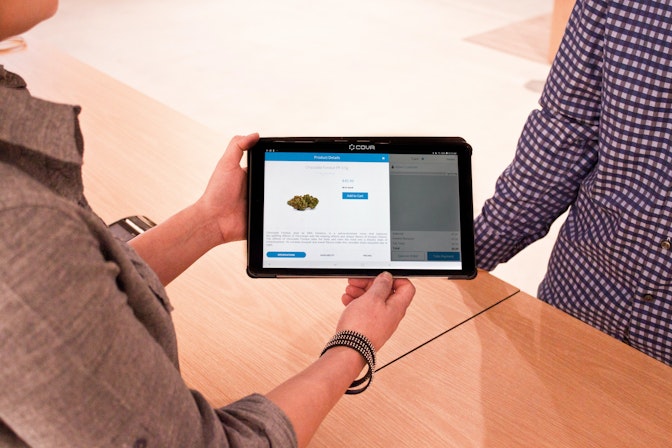If you're thinking about selling digital products, you're in luck — all you need to get started is a computer, WiFi connection, and some elbow grease.
However, diving in without a solid strategy is a recipe for disaster.
Creating digital products can take a lot of time and effort — in other words, it would suck if you spent weeks creating the 'perfect' digital product only for it not to sell, right? As the founding father Benjamin Franklin once said, "If you fail to plan, you are planning to fail!"
So, what should you sell? And how can you make sure your idea is a hit before investing all your time and energy into it?
In short, how can you start selling digital products?!
Let's find out. In this beginner's guide, we'll explore the pros and cons of selling digital products, the types of digital products you can create, and how to sell digital products online.
What Is a Digital Product?
Digital products are intangible assets or media that can be distributed online without the need to source or manage physical inventory. These products are often delivered in downloadable or streamable formats, such as PDFs, MP3s, videos, software, or templates.
7 Benefits of Selling Digital Products
- Save time: When selling digital products, you don't need to source or manage inventory. You also don't have to deal with shipping and logistics.
- Save money: Sourcing, storing, and shipping physical products costs money — as does managing inventory. With digital products, you can avoid these overheads entirely.
- Scalable: Digital products are infinitely scalable. There's very little difference between delivering 10 units per day and delivering 10,000 units per day. (However, as you scale, you'll need to hire more customer service specialists and upgrade your website to handle the additional traffic.)
- High profit margins: Without the need to purchase and manage physical inventory, the profit margins on digital products are considerably high.
- Automation Potential: It's relatively easy to automate digital product delivery, which allows you to focus on growing your business.
- Flexibility: At any point, you can create new products or change the way you sell your products. For example, you may decide to give a digital product away to build your email list or sell a monthly subscription to access multiple products.
- Opportunity: E-learning was growing rapidly before COVID-19, and now more people than ever are working and learning from home. As a result, the e-learning industry is expected to be worth a whopping $374 billion by 2026.
That being said, it's not all roses…
The Drawbacks to Selling Digital Products
- Competition: It's relatively easy to start selling digital products, so the competition can be tough. Plus, whatever you plan to sell, you'll likely be competing with others offering similar content for free.
- Piracy: Thieves can easily steal and resell digital products, so you'll need to take precautions.
25 Profitable Digital Product Ideas to Sell Online
Wondering, "what digital products can I sell online?" If so, here's a quick rundown of 25 digital product ideas to sell online:
- Courses
- Videos
- Ebooks
- Written templates (scripts, résumés, emails, etc.)
- Checklists
- Spreadsheets
- Photos
- Fonts
- Icons
- Logos
- Graphics
- Infographics
- Illustrations
- Digital art
- Animations
- Graphic templates
- Overlays
- Editing presets (for images, videos, or audio)
- Online magazines
- Software
- Online tools
- Membership sites
- Audio (music, samples, loops, podcasts, etc.)
- Planners
- Research (statistics, reports, etc.)
Now, let's take a closer look.
4 Types of Digital Products to Sell Online
Broadly speaking, there are 4 main types of digital products that you can sell online:
- Educational digital products
- Digital tools and templates
- Licensed digital products
- Memberships
Let's explore each of the 4 types with some real-life examples for inspiration.
1. Educational Digital Products
Everyone wants to learn something — whether it's Twitter marketing, memorization techniques, or how to draw safari animals.
So, if you're passionate about something, why not teach it to others through digital products?
For instance, A Book Apart sells "detailed, meticulously edited" ebooks that shed light on essential topics for designers, writers, and coders.

In another example, the rock guitarist Nita Strauss sells an online video course teaching people how to play guitar.

2. Digital Tools and Templates
There are many different types of digital tools and templates that you can sell online to help people save time or do things that they can't do themselves. Here are a few examples:
- Graphic design templates for print materials, websites, or social media posts
- Plugins, presets, overlays, and filters for video and image editing software programs
- Scripts and templates for résumés and emails
Take RetroSupply Co., which sells digital assets for designers.

In another example, Jenniffer — a digital artist — sells planners on her blog, Life is Messy and Brilliant.
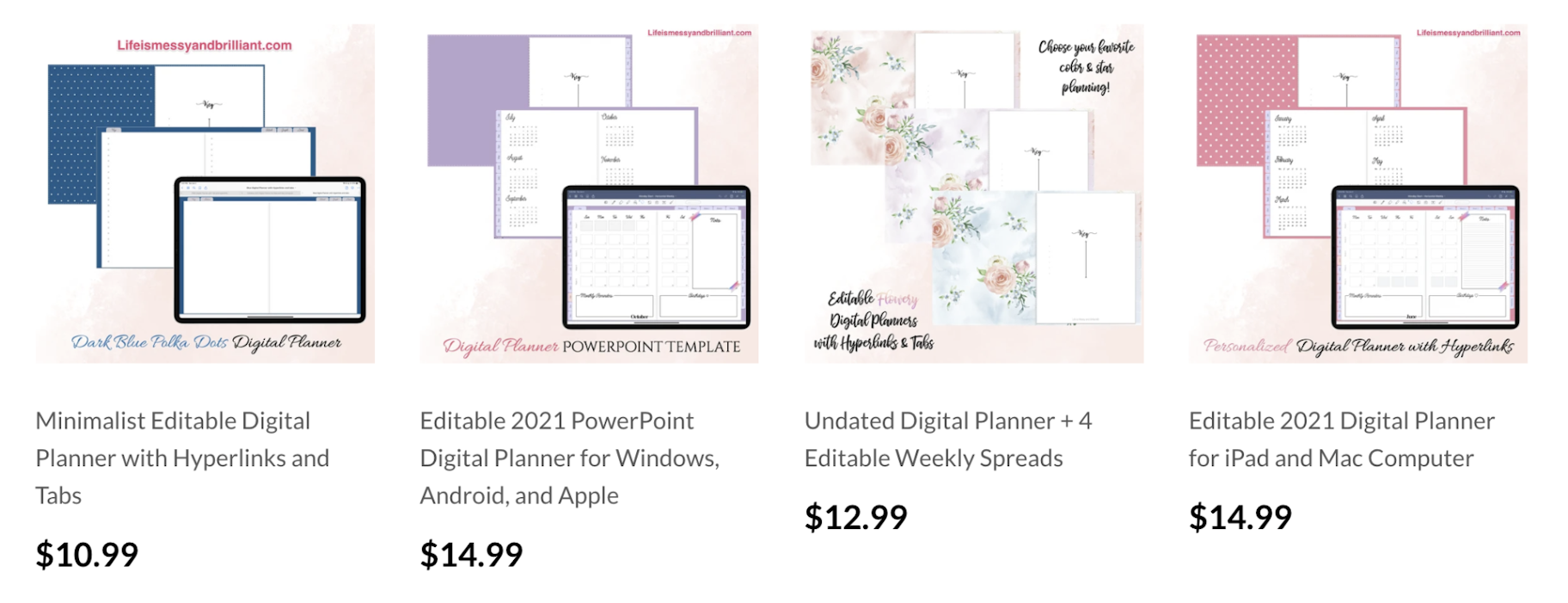
3. Licensed Digital Products
Many entrepreneurs sell licensed digital products, which are often incorporated into other works. Common examples include:
- Music loops
- Sound effects
- Stock videos and photos
- Legal contract templates
- Software
Case in point, The Loop Loft sells professionally recorded music loops and samples for musicians, producers, and DJs to use in their music.

Similarly, EditStock sells professional video footage to allow aspiring editors to hone their skills and create an editing demo reel to land work.

4. Memberships
Many entrepreneurs sell ongoing memberships that provide access to a range of digital products and services online, such as exclusive online groups, coaching, and courses.
For example, Gauge Girl Training offers 3 membership options for fitness and nutrition training, resources, and coaching.
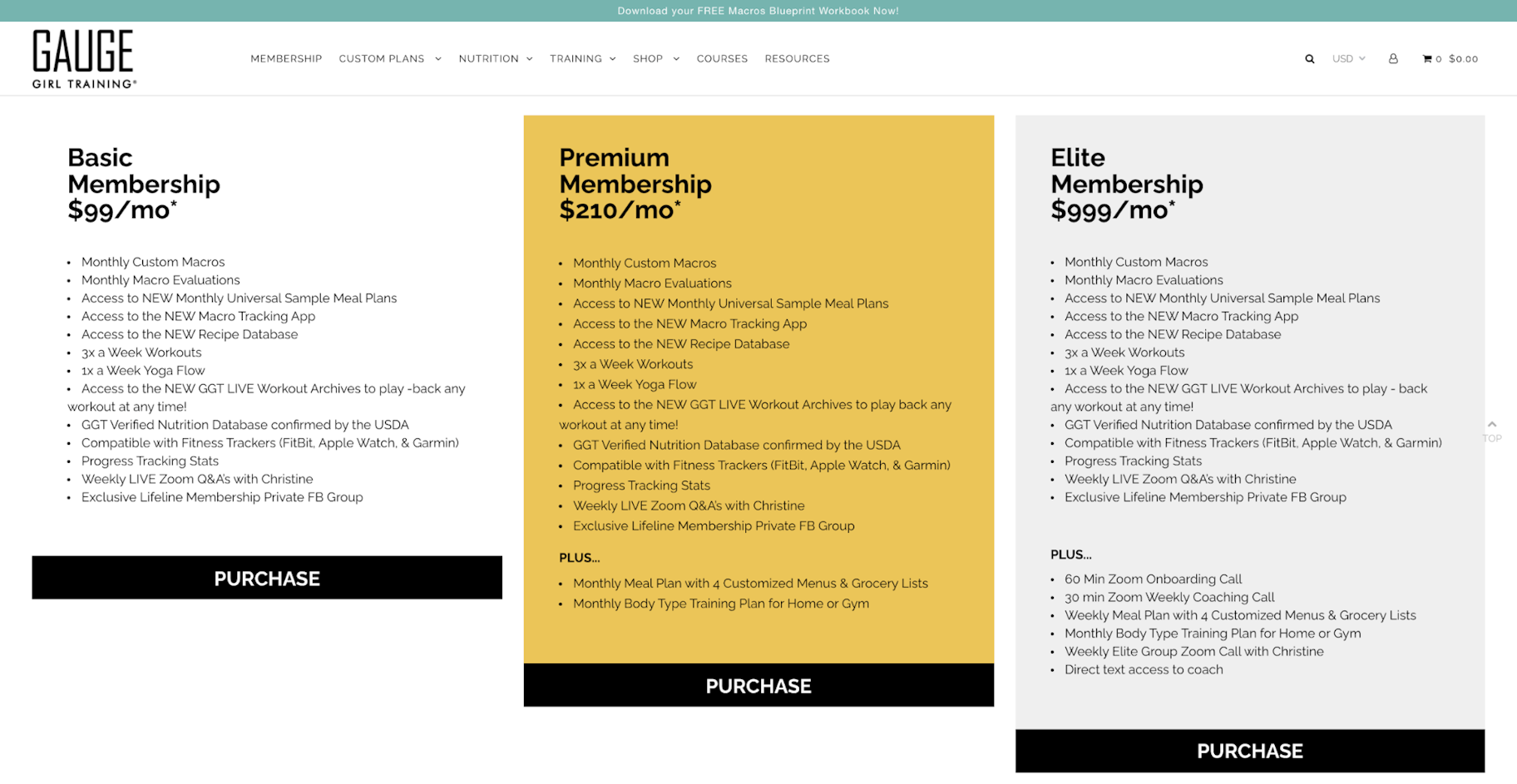
How to Sell Digital Products Online
Now that you understand the types of digital products you can sell online, how can you get started? Here's an 8-step process that you can follow to create and sell digital products online.
1. Brainstorm and Research Ideas
First things first: Grab a pen and paper and write down every digital product idea you can think of.
Don't overthink your ideas or be too critical — you can always develop a 'bad' idea into a good one. And remember, you don't have to be an expert to create a digital product — you just have to offer value in some way.
Here are some questions that may help you come up with ideas:
- What knowledge, skills, or experience do you have that you could teach others?
- What are your interests or passions — what can you talk about all day?
- If you already have a business, can you create digital products that support your physical products? For example, if you sell skateboards, could you make an online course teaching people how to improve their skateboarding skills?
- What are your values? Can you teach people how to implement those values practically? For example, if you're very environmentally conscious, can you teach others how to live a more sustainable life?
Once you've finished brainstorming, do some research.
Start with your current ideas and see what other people are selling online. Search on Google and social media platforms. Check out Facebook groups, Reddit subreddits, and industry forums.
Thoroughly explore each idea to see if there are variations or additional ideas that you can add to your list.
2. Identify a Painful Problem to Solve
Once you have a big list of ideas, it's time to switch gears and start evaluating them. During this process, think carefully about the problem that each idea solves.
For example, if you plan to teach people how to get fit at home with no equipment, you would be helping people:
- Improve their health
- Increase their confidence
- Save time and money that they'd usually spend on a gym or trainer
- Etc.
Here's the thing: The more significant and painful the problem your digital product solves, the easier it will be to market and sell.
So, once you've identified the problems each of your ideas solves, rank them from most painful to least painful. Then, choose an idea that solves one of the more painful problems.
3. Niche Down and Define a Target Market
Entrepreneurs have a saying: "The riches are in the niches."

Here's why: Setting your targets on a defined target market allows you to:
- Cater your digital products to the specific needs of your niche, making them more compelling and valuable.
- Tailor your marketing communications to your target market's particular needs, desires, and even language, allowing your messaging to hit home harder.
- Become the go-to expert in a very small niche, which will enable you to build authority and dominate the competition.
So, niche down.
For instance, instead of teaching people how to get fit, perhaps you could teach injured people how to workout safely. Or maybe you could show moms how to get fit and increase their energy with home workouts they can do with their kids.
Get crazy specific.
4. Validate Your Idea
You don't want to pour your heart and soul into creating digital products that don't sell. So, before making your first digital product, it's best to validate your idea.
Start with some basic research:
- Use Google's Keyword Planner to see how many people are searching for terms related to your idea.
- Check Google Trends to ensure demand for your idea is growing — or at least steady.
- Reach out to your target market on social media and ask for feedback on your idea. You could even create a poll or survey.
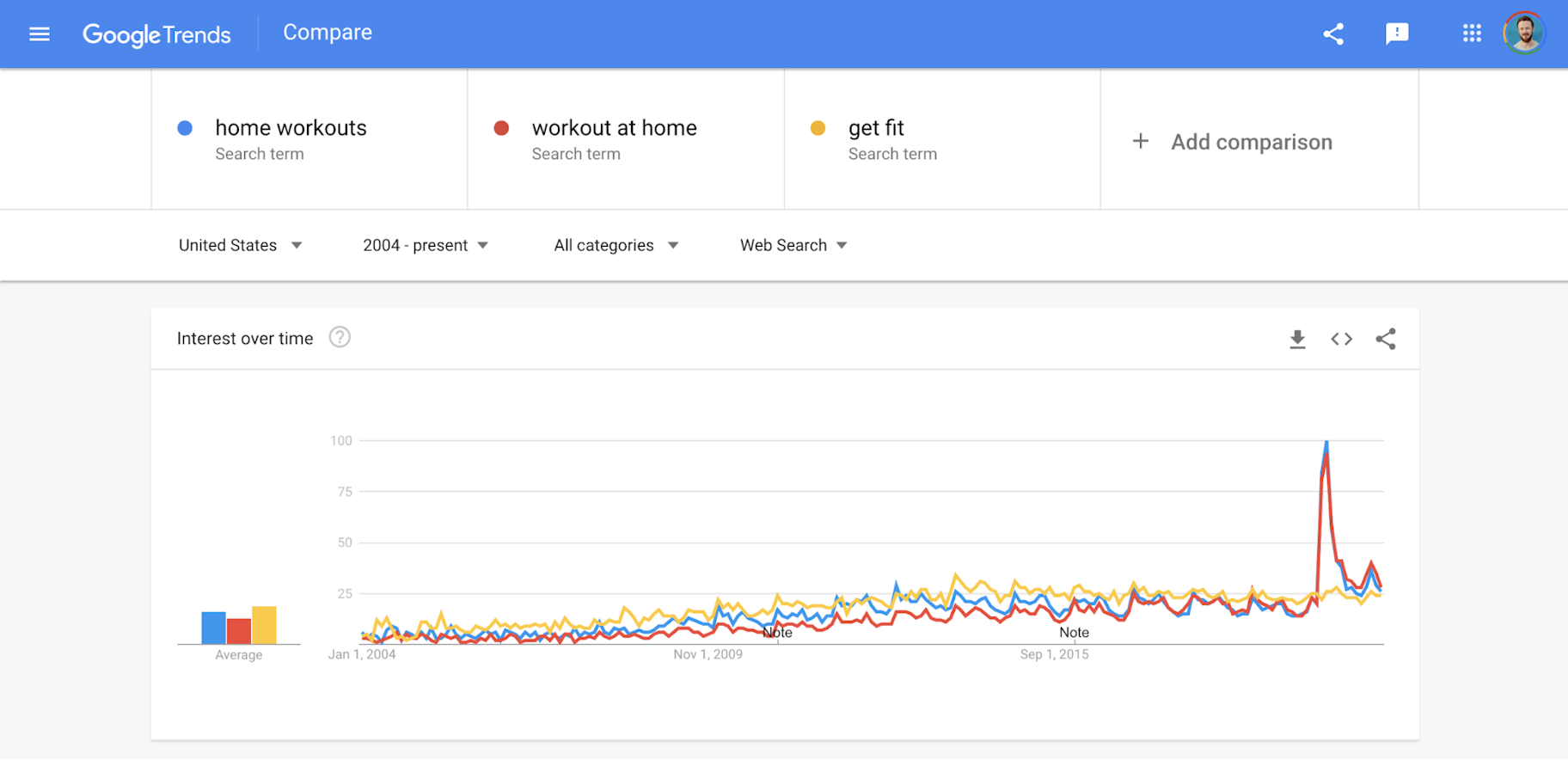
Then, create a minimal viable product or 'MVP' to test your idea in the real world.
For example, instead of building an 8-week video course on how to get fit, start by offering online fitness coaching. This way, you can test your product-market fit without investing too much time.
5. Create Your Digital Product to Sell Online
Once you've validated a winning idea, it's time to create your digital product. If you haven't already, you'll need to choose a format.
If possible, choose a simple format at first — you can always improve your digital products as you learn more about your customer's needs and desires.
To continue with our example above, if you plan on creating a video course with downloadable resources, perhaps continue to offer coaching calls and start making the downloadable resources first.
6. Create an Online Store
Wondering where to sell digital products? Let's cut to the chase: Shopify is the best platform to sell digital products online — and it only costs $39 per month.
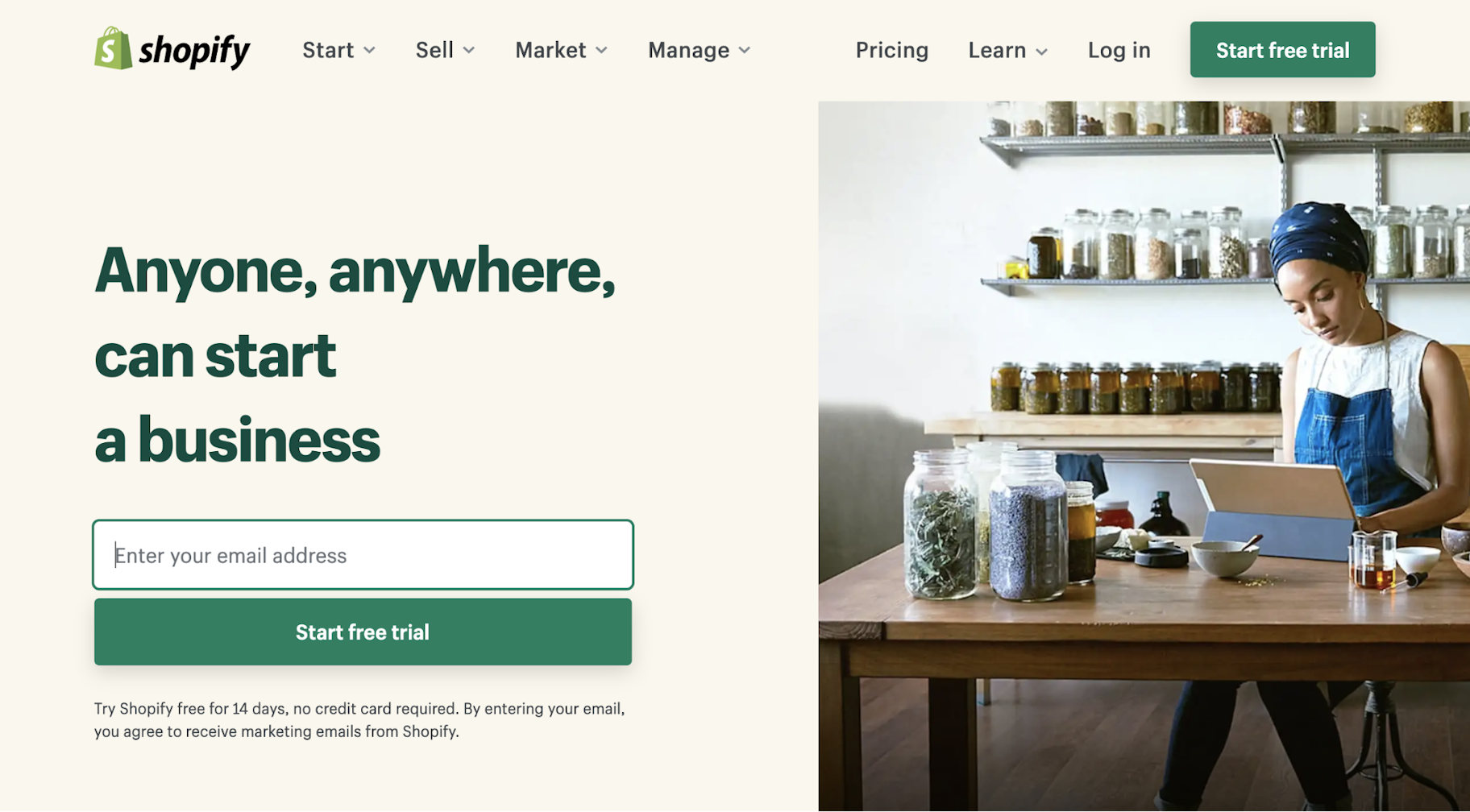
This ecommerce website builder comes with more than 100 website themes that you can use to customize your store. Plus, the Shopify app store has countless apps that allow you to tailor your website's functionality to your specific needs.
Here are 10 apps to consider when selling digital products:
- Digital Downloads
- SendOwl
- FetchApp
- Courses
- Thinkific
- Single Music
- Bold Memberships
- BookThatApp
- Recurring Order & Subscription
- Photolock
Top tip: When selling digital products with Shopify, you'll need to disable the shipping option.
7. Drive Traffic
Once you're all set up, it's time to drive sales. Here are 7 types of internet marketing that you can use to generate sales:
- Paid advertising: Advertise on platforms like Google Ads and Facebook Ads.
- Social media marketing: Share content and engage your target market on social media platforms like Facebook, Instagram, and YouTube.
- Influencer marketing: Partner with influencers to promote your offers to their audience.
- Content marketing: Create and share engaging content to attract and convert people into customers.
- Search engine optimization (SEO): Optimize your website and content to rank higher in the search engine results pages (SERPs) to generate qualified web traffic.
- Email marketing: Capture potential customers' contact information and nurture them into paying customers.
- Affiliate marketing: Incentivize third-party marketers to promote your offers in exchange for a fee or commission.
Start Selling Digital Products Online
Selling digital products is highly scalable as they allow you to sidestep having to source, store, and ship physical products.
Plus, there are many types of digital products that you can sell online, from ebooks and video courses to stock footage and graphic design templates.
→ Click Here to Launch Your Online Business with Shopify
If you want to know how to create digital products to sell online, follow these steps:
- Brainstorm and research digital product ideas
- Identify a painful problem to solve
- Niche down and define a target market
Once you have a great idea, here's how to sell digital products online:
- Validate your idea to ensure it's a winner
- Create your digital product
- Build an online store to sell digital products
- Drive traffic with digital marketing
What type of digital product are you thinking about selling? Let us know in the comments below!
Want to Learn More?


